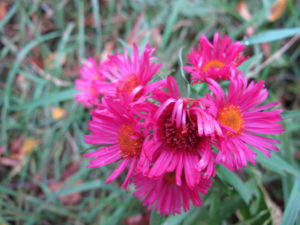Staying Busy in the Garden’s Slow Time
Winter is our slow season, and many gardeners begin to languish as January finishes and spring is still far away. It is important to keep busy. For me, this means reading gardening books and magazines, and working on small tasks that can be done indoors now. Preparing plant labels is one of many tasks that can be tedious in summer, but pleasant in winter.
First, you might wonder, why bother with plant labels? There are several reasons. First, labels show you exactly where a plant will appear, come spring or summer. Blue balloon flower (Platycodon grandiflora), for example, stays dormant weeks past other perennials in the spring. It would be easy to disturb the roots of this plant in spring by digging a spot for a new perennial that needs a home. A label will prevent that.
Second, we forget names. I like to use the Latin or scientific name for plants with labels because if I have that, I will probably remember the common name. I like to include the cultivar or variety name, too, as visitors to the garden often ask me things like “So which aster is that?” If my tag includes ‘Alma Potschke’ or ‘Barr’s Pink’, I can help a fellow gardener find the variety they saw in my garden.
Labels can include lots of information. I generally include the year that I planted a perennial, and the source. The year will allow me to see how long a plant has survived in my garden, and how long it takes to reach a mature size. That will inform decisions I will make about planting others of the same species.
Many perennials die out after a period of time – perhaps 3 years, or perhaps 10. Please don’t assume it’s your fault if a perennial dies,. Most perennials, like people and pets, have a lifespan. Your labels will remind you how long your plants have been around.
That said, I have a peony that is the descendant of one my grandmother grew, and she died in 1953. My mom grew it, then I got a division. I don’t have a tag on it, but wish I did. I suspect I planted it at my house in the early 1980’s. Peonies are essentially forever, so plant them well.
Plant labels can be distracting, of course. The most common labels are made of white plastic about half an inch wide and 4 to 6 inches long. I prefer the longer ones, as there is more room for information. One side is usually slicker, one more grainy. I use the rough side with a #2 pencil for best results. Pencil, outdoors, lasts longer than pen or even a Sharpie. Both of those fade in sun.
If you are using many labels, your garden bed can start to look like a mouse graveyard with its little white markers. To avoid this I push the plant tag deep into the soil, leaving just an inch or less above ground. When I want the info, I pull the tag. And I always place the tag in the same relative position to the plant. I place them behind the plant and a little to the right of center. That way if it gets covered with soil or mulch, I can dig around with my fingers and find it.
Also available are bigger metal tags that are attached to 2 wire legs. Some of these come with a marker that is filled with paint that is said to last well outdoors. Others are soft metal like copper that can be permanently engraved with a nail or awl that either scratches the surface, or dents it.
Most perennials purchased from a nursery will come with a pre-printed plastic tag that will tell you everything you need to know except the year you bought it. Those tags, if left out to the elements, will start to break down in five years or so. Again, burying 90% of the tag will help it last longer.
If you are an “artsy” sort of person, this would be a good time to make some hand-painted plant labels for your garden. Use outdoor grade plywood or perhaps cedar for the markers. Vegetable gardens, where seeds are planted, are commonly adorned with nice custom-made labels. If you paint the tags, you might them coat them with a layer of marine varnish or the like.
Trees and shrubs often arrive with a tag that is looped around the trunk or a branch. Beware of these: some are attached with wire, or a wire coated with something. I once lost a rare tree, a dawn redwood, to strangulation. The tag looped around the base of the tree, and the tree eventually strangled as the wire cut into the cambium layer of the bark.
So how can you remember the plants in your garden, now, in winter? Most of us take pictures with a digital camera, and store them on the computer. Take some time to enjoy looking at your garden photos now. Not only that, if you took the pictures when you first planted things, the date will be on the photo.
I’ll have to admit I haven’t gotten around to making any plant labels right now, in winter. I got distracted looking at my gardens on my computer and admiring my flowers. Going through my photos month-by-month has helped me to see what flowers I need to purchase this spring, replacing those that have disappeared with time.
Henry is the author of 4 gardening books. He lives in Cornish Flat, NH. You may reach him at henry.homeyer@comcast.net.





